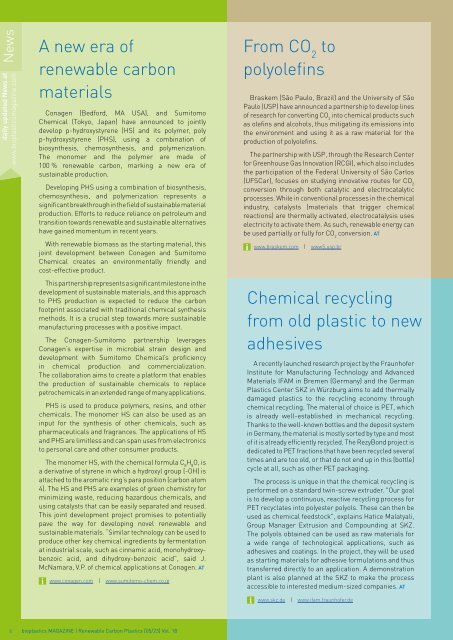Issue 05/2023
Highlights Fibres / Textiles Polyurethane / Elastomers
Highlights
Fibres / Textiles
Polyurethane / Elastomers
Create successful ePaper yourself
Turn your PDF publications into a flip-book with our unique Google optimized e-Paper software.
News<br />
daily updated News at<br />
www.bioplasticsmagazine.com<br />
A new era of<br />
renewable carbon<br />
materials<br />
Conagen (Bedford, MA USA), and Sumitomo<br />
Chemical (Tokyo, Japan) have announced to jointly<br />
develop p-hydroxystyrene (HS) and its polymer, poly<br />
p-hydroxystyrene (PHS), using a combination of<br />
biosynthesis, chemosynthesis, and polymerization.<br />
The monomer and the polymer are made of<br />
100 % renewable carbon, marking a new era of<br />
sustainable production.<br />
Developing PHS using a combination of biosynthesis,<br />
chemosynthesis, and polymerization represents a<br />
significant breakthrough in the field of sustainable material<br />
production. Efforts to reduce reliance on petroleum and<br />
transition towards renewable and sustainable alternatives<br />
have gained momentum in recent years.<br />
With renewable biomass as the starting material, this<br />
joint development between Conagen and Sumitomo<br />
Chemical creates an environmentally friendly and<br />
cost-effective product.<br />
This partnership represents a significant milestone in the<br />
development of sustainable materials, and this approach<br />
to PHS production is expected to reduce the carbon<br />
footprint associated with traditional chemical synthesis<br />
methods. It is a crucial step towards more sustainable<br />
manufacturing processes with a positive impact.<br />
The Conagen-Sumitomo partnership leverages<br />
Conagen’s expertise in microbial strain design and<br />
development with Sumitomo Chemical’s proficiency<br />
in chemical production and commercialization.<br />
The collaboration aims to create a platform that enables<br />
the production of sustainable chemicals to replace<br />
petrochemicals in an extended range of many applications.<br />
PHS is used to produce polymers, resins, and other<br />
chemicals. The monomer HS can also be used as an<br />
input for the synthesis of other chemicals, such as<br />
pharmaceuticals and fragrances. The applications of HS<br />
and PHS are limitless and can span uses from electronics<br />
to personal care and other consumer products.<br />
The monomer HS, with the chemical formula C 8<br />
H 8<br />
O, is<br />
a derivative of styrene in which a hydroxyl group (-OH) is<br />
attached to the aromatic ring’s para position (carbon atom<br />
4). The HS and PHS are examples of green chemistry for<br />
minimizing waste, reducing hazardous chemicals, and<br />
using catalysts that can be easily separated and reused.<br />
This joint development project promises to potentially<br />
pave the way for developing novel renewable and<br />
sustainable materials. “Similar technology can be used to<br />
produce other key chemical ingredients by fermentation<br />
at industrial scale, such as cinnamic acid, monohydroxybenzoic<br />
acid, and dihydroxy-benzoic acid”, said J.<br />
McNamara, V.P. of chemical applications at Conagen. AT<br />
www.conagen.com | www.sumitomo-chem.co.jp<br />
From CO 2<br />
to<br />
polyolefins<br />
Braskem (São Paulo, Brazil) and the University of São<br />
Paulo (USP) have announced a partnership to develop lines<br />
of research for converting CO 2<br />
into chemical products such<br />
as olefins and alcohols, thus mitigating its emissions into<br />
the environment and using it as a raw material for the<br />
production of polyolefins.<br />
The partnership with USP, through the Research Center<br />
for Greenhouse Gas Innovation (RCGI), which also includes<br />
the participation of the Federal University of São Carlos<br />
(UFSCar), focuses on studying innovative routes for CO 2<br />
conversion through both catalytic and electrocatalytic<br />
processes. While in conventional processes in the chemical<br />
industry, catalysts (materials that trigger chemical<br />
reactions) are thermally activated, electrocatalysis uses<br />
electricity to activate them. As such, renewable energy can<br />
be used partially or fully for CO 2<br />
conversion. AT<br />
www.braskem.com | www5.usp.br<br />
Chemical recycling<br />
from old plastic to new<br />
adhesives<br />
A recently launched research project by the Fraunhofer<br />
Institute for Manufacturing Technology and Advanced<br />
Materials IFAM in Bremen (Germany) and the German<br />
Plastics Center SKZ in Würzburg aims to add thermally<br />
damaged plastics to the recycling economy through<br />
chemical recycling. The material of choice is PET, which<br />
is already well-established in mechanical recycling.<br />
Thanks to the well-known bottles and the deposit system<br />
in Germany, the material is mostly sorted by type and most<br />
of it is already efficiently recycled. The RezyBond project is<br />
dedicated to PET fractions that have been recycled several<br />
times and are too old, or that do not end up in this (bottle)<br />
cycle at all, such as other PET packaging.<br />
The process is unique in that the chemical recycling is<br />
performed on a standard twin-screw extruder. "Our goal<br />
is to develop a continuous, reactive recycling process for<br />
PET recyclates into polyester polyols. These can then be<br />
used as chemical feedstock", explains Hatice Malatyali,<br />
Group Manager Extrusion and Compounding at SKZ.<br />
The polyols obtained can be used as raw materials for<br />
a wide range of technological applications, such as<br />
adhesives and coatings. In the project, they will be used<br />
as starting materials for adhesive formulations and thus<br />
transferred directly to an application. A demonstration<br />
plant is also planned at the SKZ to make the process<br />
accessible to interested medium-sized companies. AT<br />
www.skz.de | www.ifam.fraunhofer.de<br />
6 bioplastics MAGAZINE | Renewable Carbon Plastics [<strong>05</strong>/23] Vol. 18

















